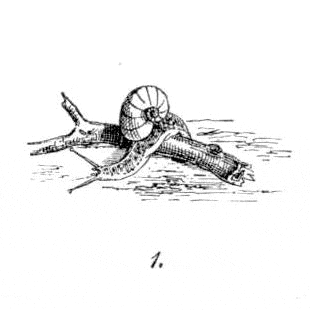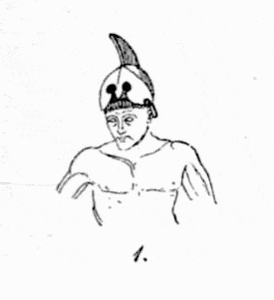by guest contributor Laurel Waycott
In 1893, Henry Balfour, curator of the Pitt Rivers Museum in Oxford, UK, conducted an experiment. He traced a drawing of a snail crawling over a twig, and passed it to another person, whom he instructed to copy the drawing as accurately as possible with pen and paper. This second drawing was then passed to the next participant, with Balfour’s original drawing removed, and so on down the line. Balfour, in essence, constructed a nineteenth-century version of the game of telephone, with a piece of gastropodic visual art taking the place of whispered phrases. As in the case of the children’s game, what began as a relatively easy echo of what came before resulted in a bizarre, near unrecognizable transmutation.

Plate I. Henry Balfour, The Evolution of Decorative Art (New York: Macmillan & Co., 1893).
In the series of drawings, Balfour’s pastoral snail morphed, drawing by drawing, into a stylized bird—the snail’s eyestalks became the forked tail of the bird, while the spiral shell became, in Balfour’s words, “an unwieldy and unnecessary wart upon the, shall we call them, ‘trousers’ which were once the branching end of the twig” (28). Snails on twigs, birds in trousers—just what, exactly, are we to make of Balfour’s intentions for his experiment? What was Balfour trying to prove?
Balfour’s game of visual telephone, at its heart, was an attempt to understand how ornamental forms could change over time, using the logic of biological evolution. The results were published in a book, The Evolution of Decorative Art, which was largely devoted to the study of so-called “primitive” arts from the Pacific. The reason that Balfour had to rely on his constructed game and experimental results, rather than original samples of the “savage” art, was that he lacked a complete series necessary for illustrating his theory—he was forced to create one for his purposes. Balfour’s drawing experiment was inspired by a technique developed by General Pitt Rivers himself, whose collections formed the foundation of the museum. In 1875, Pitt Rivers—then known as Augustus Henry Lane Fox—delivered a lecture titled “The Evolution of Culture,” in which he argued that shifting forms of artifacts, from firearms to poetry, were in fact culminations of many small changes; and that the historical development of artifacts could be reconstructed by observing these minute changes. From this, Pitt Rivers devised a scheme of museum organization that arranged objects in genealogical fashion—best illustrated by his famous display of weapons used by the indigenous people of Australia.

Plate III. Augustus Henry Lane-Fox Pitt-Rivers, The Evolution of Culture, and Other Essays, ed. John Linton Myres (Oxford, Clarendon Press, 1906).
Here, Pitt Rivers arranged the weapons in a series of changing relationships radiating out from a central object, the “simple cylindrical stick” (34). In Pitt Rivers’ system, this central object was the most “primitive” and “essential” object, from which numerous small modifications could be made. Elongate the stick, and eventually one arrived at a lance; add a bend, and it slowly formed into a boomerang. While he acknowledged that these specimens were contemporary and not ancient, the organization implied a temporal relationship between the objects. This same logic was extended to understandings of human groups at the turn of the twentieth century. So-called “primitive” societies like the indigenous groups of the Pacific were considered “survivals” from the past, physically present but temporally removed from those living around them (37). The drawing game, developed by Pitt Rivers in 1884, served as a different way to manipulate time: by speeding up the process of cultural evolution, researchers could mimic evolution’s slow process of change over time in the span of just a few minutes. If the fruit fly’s rapid reproductive cycle made it an ideal model organism for studying Mendelian heredity, the drawing game sought to make cultural change an object of the laboratory.
It is important to note the capacious, wide-ranging definitions of “evolution” by the end of the nineteenth century. Evolution could refer to the large-scale, linear development of entire human or animal groups, but it could also refer to Darwinian natural selection. Balfour drew on both definitions, and developed tools to help him to apply evolutionary theory directly to studies of decorative art. “Degeneration,” the idea that organisms could revert back to earlier forms of evolution, played a reoccurring role in both Balfour’s and Pitt Rivers’ lines of museum object-based study. For reasons never explicitly stated, both men assumed that decorative motifs originated with realistic images, relying on the conventions of verisimilitude common in Western art. This leads us back, then, to the somewhat perplexing drawing with which Balfour chose to begin his experiment.

Balfour wrote that he started his experiment by making “a rough sketch of some object which could be easily recognized” (24). His original gastropodic image relied, fittingly, on a number of conventions that required a trained eye and trained hand to interpret. The snail’s shell and the twig, for instance, appeared rounded through the artist’s use of cross-hatching, the precise placement of regularly spaced lines which lend a sense of three-dimensional volume to a drawing. Similarly, the snail’s shell was placed in a vague landscape, surrounded by roughly-sketched lines giving a general sense of the surface upon which the action occurred. While the small illustration might initially seem like a straightforward portrayal of a gastropod suctioned onto a twig, the drawing’s visual interpretation is only obvious to those accustomed to reading and reproducing the visual conventions of Western art. Since the image was relatively challenging to begin with, it provided Balfour with an exciting experimental result: specifically, a bird wearing trousers.

Plate II. Henry Balfour, The Evolution of Decorative Art (New York: Macmillan & Co., 1893).
Balfour had conducted a similar experiment using a drawing of a man from the Parthenon frieze as his “seed,” but it failed to yield the surprising results of the first. While the particulars of the drawing changed, somewhat—the pectoral muscles became a cloak, the hat changed, and the individual’s gender got a little murky in the middle—the overall substance of the image remained unchanged. It did not exhibit evolutionary “degeneration” to the same convincing degree, but rather seemed to be, quite simply, the product of some less-than-stellar artists. While Balfour included both illustrations in his book, he clearly preferred his snail-to-bird illustration and reproduced it far more widely. He also admitted to interfering in the experimental process: omitting subsequent drawings that did not add useful evidence to his argument, and specifically choosing participants who had no artistic training (25, 27).
Balfour clearly manipulated his experiment and the resulting data to prove what he thought he already knew: that successive copying in art led to degenerate, overly conventionalized forms that no longer held to Western standards of verisimilitude. It was an outlook he had likely acquired from Pitt Rivers. In Notes and Queries on Anthropology (1892), a handbook circulated to travelers who wished to gather ethnographic data for anthropologists back in Britain, Pitt Rivers outlined a number of questions that travelers should ask about local art. The questions were leading, designed in a simple yes/no format likely to provoke a certain response. In fact, one of Pitt Rivers’ questions could, essentially, offer the verbal version of Balfour’s drawing game. “Do they,” he wrote, “in copying from one another, vary the designs through negligence, inability, or other causes, so as to lose sight of the original objects, and produce conventionalized forms, the meaning of which is otherwise inexplicable?” (119–21). Pitt Rivers left very little leeway—both for the artist and the observer—for creativity. Might the artists choose to depict things in a certain way? And might the observer interpret these depictions in his or her own way? Pitt River’s motivation was clear. If one did find such examples of copying, he added. “it would be of great interest to obtain series of such drawings, showing the gradual departure from the original designs.” They would, after all, make a very convincing museum display.
Laurel Waycott is a PhD candidate in the history of science and medicine at Yale University. This essay is adapted from a portion of her dissertation, which examines the way biological thinking shaped conceptions of decoration, ornament, and pattern at the turn of the 20th century.



1 Pingback